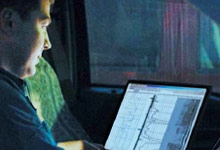- Home page /
- New technologies and equipment /
- Two-way telemetry ushers in a new era for slickline
Two-way telemetry ushers in a new era for slickline
08.05.2012

Slickline methods have changed little in the more than 75 years they’ve been in use; basic downhole operations have been performed through the manipulation of downhole tools attached to the end of this single thin wire. When using this method, however, the precise location and status of deployed tools is difficult to verify. Recently, engineers developed digital slickline to provide operators with accurate downhole information during operations, enabling better tool placement, control and clarity of operation.
Slickline has remained a well intervention staple because it is cost effective, reliable, efficient, and logistically uncomplicated. Slickline is deployed with relative ease using compact equipment that may be moved to and situated at a wellsite of nearly any size. On locations with space or weight limitations, slickline is often the only feasible intervention option.
The simplicity of slickline is also the source of its drawbacks. Slickline was designed initially to perform rudimentary mechanical operations in circumstances where depth accuracy was not a major consideration. The true amount of force being delivered downhole can only be estimated, and there is no way to confirm that an intended downhole action has been completed without pulling out of the hole. The use of battery- powered electronic tools has expanded the services run on slickline, but with limitations and inefficiencies due to the absence of real time information and surface in situ control.
For years, engineers have sought to enhance slickline capabilities by developing a system that uses the wire itself to deliver two-way signals between the tool and the surface. Using this telemetry in conjunction with purpose built downhole tools, slickline operators could determine precise depth, tool status, downhole weight, wire tension, and wellbore environment data, such as pressure and temperature, in real time. Many years attempting to evolve slickline followed, but manufacturers were unable to develop an insulation coating that could withstand the environment and means in which it is deployed. That changed recently when engineers at Geoservices, a Schlumberger company, developed LIVE digital slickline (DSL) services.
LIVE digital slickline services enable a wider range of activities to be performed with control and certainty. A digital slickline has an integral coating for digital two-way communication and is deployed using a standard slickline unit and pressure control equipment. Sensors in the downhole digital cartridge measure cable tension, detect shock and well deviation, and monitor internal temperature. Data transmission is not affected by well completions, conditions, or fluids.

